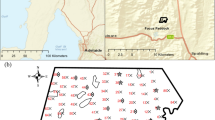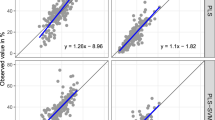Abstract
The development of a rapid, accurate and cost-effective method for the prediction of constituents related to soil nitrogen (N) supply is considered important. The potential of using visible (Vis) and near infrared reflectance (NIR) spectroscopy (400–2500 nm) as such a method was investigated. Vis–NIR calibrations were performed for organic carbon (Corg) and total N (Ntot) content and their potential mineralisation using 80 grassland soil samples of rather heterogeneous origin. Prediction accuracy was tested using a 'take-out-four' validation strategy (48 samples). Within investigated variables a ratio of standard deviation of reference data to standard error of bias corrected prediction (RPD) within 1.7 (r2=0.65) and 2.7 (r2=0.87) were achieved. Apparent differences in Vis–NIR prediction accuracy among the variables were partly due to errors in the reference values. Thawed moist samples tend to be more accurately predicted than dried samples, and no benefit was derived from the grinding of sieved (4 mm) and dried samples. Prediction accuracy did not differ using two different systems for sample presentation to the Vis–NIR analyses. Comparative predictions of Corg and Ntot and their potential mineralisations were performed using the take-out-four validation strategy and simple linear regression to loss on ignition (LOI) values and hot KCl extracted NH4-N (NhotKCl) values as predictors. Likewise, the reference values of Corg and Ntot were also used as predictors for each other and for the potential C and N mineralisation constituents. Accuracy obtained for the Vis–NIR predictions of investigated constituents was in general equal or better than prediction accuracy obtained by these comparative methods. The Vis–NIR method provided promising predictions of variables important for the soil N supply.
Similar content being viewed by others
References
Al-Abbas A H, Swain P H and Baumgardner M F 1972 Relating organic matter and clay content to the multispectral radiance of soils. Soil Sci. 114, 477-485.
Azam F, Simmons F W and Mulvaney R L 1993 Mineralization of N from plant residues and its interaction with native soil N. Soil Biol. Biochem. 25(12), 1787-1792.
Barnes R J, Dhanoa M S and Lister S J 1989 Standard normal variate transformation and detrending of NIR spectra. Appl. Spectrosc. 43, 772-777.
Ben-Dor E and Banin A 1995 Near-Infrared analysis as a rapid method to simultaneously evaluate several soil properties. Soil Sci. Soc. Am. J. 59, 364-372.
Bowers S A and Hanks R J 1965 Reflection of radiant energy from soils. Soil Sci. 100, 130-138.
Börjesson T, Stenberg B, Lindén B and Jonsson A 1999 NIR spectroscopy, mineral nitrogen analysis and soil incubations for the prediction of crop uptake of nitrogen during the growing season. Plant Soil 214, 75-83.
Chang C-W, Laird D A, Mausbach M J and Hurburgh C R Jr 2001 Near-infrared reflectance spectroscopy-principal components regression analyses of soil properties. Soil Sci. Soc. Am. J. 65, 480-490.
Couillard A, Turgeon A J, Shenk J S and Westerhaus M O 1997 Near infrared reflectance spectroscopy for analysis of turf soil profiles. Crop Sci. 37, 1554-1559.
Dalal R C and Henry R J 1986 Simultaneous determination of moisture, organic carbon, and total nitrogen by near infrared reflectance spectrophotometry. Soil Sci. Soc. Am. J. 50, 120-123.
Elonen P 1971 Particle size analysis of soil. Acta Agralia Fenn. 122, 122 p.
Fox R H, Shenck J S, Piekielek W P, Westerhaus M O, Toth J D and Macneal K E 1993 Comparison of near-infrared spectroscopy and other soil nitrogen availability quick tests for corn. Agron. J. 85, 1049-1053.
Fystro G 2000 Determination of potential carbon and nitrogen mineralisation in soil by near infrared reflectance spectroscopy. In Grassland Farming-Balancing Environmental and Economic. Eds. K Søegaard, C Ohlsson, J Sehested, N J Hutchings and T Kristensen. Proceedings of the 18th EGF Meeting, Aalborg, Denmark. Grassland Science in Europe. 5, 388-390.
Gillion D, Joffre R and Dardenne P 1993 Predicting the stage of decomposing leaves by near infrared reflectance spectroscopy. Can. J. For. Res. 23, 2552-2559.
Hassink J, Bouwman L A, Zwart K B and Brussaard L 1993 Relationships between habitable pore space, soil biota and mineralization rates in grassland soils. Soil Biol. Biochem. 25(1), 47-55.
Indahl U G and Næs T 1998 Evaluation of alternative spectral feature extraction methods of textural images for multivariate modeling. J. Chemometrics 12, 261-278.
Jarvis S C, Stockdale E A, Shepherd MA and Powlson D S 1996 Nitrogen mineralization in temperate agricultural soils: processes and measurement. Adv. Agron. 57, 188-235.
Joffre R, Gillon D, Dardenne P, Agneessens R and Biston R 1992 The use of near-infrared reflectance spectroscopy in litter decomposition studies. Ann. Sci. For. 49, 481-488.
Joffre R, Ågren G I, Gillon D and Bosatta E 2001 Organic matter quality in ecological studies: theory meets experiment. Oikos 93, 451-458.
Mahalanobis P C 1936 On the generalized distance in statistics. Proc. Natl. Inst. Sci. India 2, 49-55.
Malley D F, Martin P D, McClintock L M, Yesmin L, Eilers R G and Haluschak P 2000 Feasibility of analysing archived Canadian prairie agricultural soils by near infrared reflectance spectroscopy. In Near Infrared Spectroscopy: Proceedings of the 9th International Conference. Eds. A M C Davis and R Giangiacomo. pp 579-585. NIR Publications, Chichester, UK, Verona, Italy.
Miller J C and Miller J N 1993 Statistics for Analytical Chemistry. Third edition. Ellis Horwood PTR Prentice Hall, NY, USA. 233 p. 149
Morra M J, Hall M H and Freeborn L L 1991 Carbon and nitrogen analysis of soil fractions using near-infrared reflectance spectroscopy. Soil Sci. Soc. Am. J. 55, 288-291.
Nelson D W and Sommers L E 1980 Total nitrogen analysis of soil and plant tissues. J. Assoc. Off. Anal. Chem. 63, 770-780.
Palmborg C and Nordgren A 1993 Modelling microbial activity and biomass in forest soil with substrate quality measured using near infrared reflectance spectroscopy. Soil Biol. Biochem. 25, 1713-1718.
Rowell D L 1994 Soil Science; Methods and Applications. pp 117-119. Longman Scientific & Technical, Harlow.
SAS Institute Inc. 1989 SAS/STAT® user's guide, version 6, fourth edition, vol. 2. SAS Inst., Cary, NC.
Shenk J S and Westerhaus M O 1991a Population definition, sample selection, and calibration procedures for near infrared reflectance spectroscopy. Crop Sci. 31, 469-474.
Shenk J S and Westerhaus M O 1991b Population structuring of near infrared spectra and modified partial least square regression. Crop Sci. 31, 1548-1555.
Shenk J S, Westerhaus M O and Abrams S M 1989 2. Protocol for NIRS calibration: monitoring analysis results and recalibration. In Near Infrared Reflectance Spectroscopy (NIRS): Analysis of Forage Quality. Eds. G C Marten, J S Shenk and F E Barten II. pp. 104-110. USDA, Springfield, VA.
Shepherd M A, Stockdale E A, Powlson D S and Jarvis S C 1996 The influence of organic nitrogen mineralization on the management of agricultural systems in the UK. Soil Use Manag. 12, 76-85.
Stenberg B, Nordkvist E and Salomonsson L 1995 Use of near infrared reflectance spectra of soils for objective selection of samples. Soil Sci. 159, 109-114.
Westerhaus M O 1989 Equation development. In Near Infrared Re-flectance Spectroscopy (NIRS): Analysis of Forage Quality. Eds. G C Marten, J S Shenk and F. E. Barten II. pp. 38-39. USDA, Springfield, VA.
Wetzel D L 1983 Near-infrared reflectance analysis: sleeper among spectroscopic techniques. Anal. Chem. 55: 1165A-1176A.
Williams P and Sobering D 1996 How do we do it: a brief summary of the methods we use in developing near infrared calibrations. In Near Infrared Spectroscopy: The Future Waves. Eds. A M C Davis and P Williams. pp. 185-188. NIR Publications, Chichester, UK, Montreal, Canada.
Williams P C 1987 Variables affecting near infrared reflectance spectroscopic analysis. In Near Infrared Technology in the Agricultural and Food Industries. Eds. P C Williams and K H Norris. pp. 143-167. American Association of Cereal Chemists Inc, St Paul, Mn.
Windham W R and Coleman S W 1989 Animal response prediction. In Near Infrared Reflectance Spectroscopy (NIRS): Analysis of Forage Quality. Eds. G C Marten, J S Shenk and F E Barten II. pp 32-35. USDA, Springfield, VA.
Windham W R, Mertens D R and Barton F E II 1989 1. Protocol for NIRS calibration: sample selection and equation developement and validation. In Near Infrared Reflectance Spectroscopy (NIRS): Analysis of Forage Quality. Eds. G C Marten, J S Shenk and F E Barten II. pp. 96-103. USDA, Springfield, VA.
Wold S 1978 Cross-validatory estimation of the number of components in factor and principal components models. Technometrics 20(4), 397-404.
Wold S, Martens H and Wold H 1983 The multivariate calibration problem in chemistry solved by the PLS method. Lecture Notes Math. 973, 286-293.
Øien A and Krogstad T 1989 Soil analysis. I. Theory of methods and instruments. pp. 71-74. In Norwegian. Department of Soil Science, Agricultural University of Norway.
Øien A and Selmer-Olsen A R 1980 A laboratory method for evaluation of available nitrogen in soil. Acta Agric. Scand. 30, 149-156.
Author information
Authors and Affiliations
Rights and permissions
About this article
Cite this article
Fystro, G. The prediction of C and N content and their potential mineralisation in heterogeneous soil samples using Vis–NIR spectroscopy and comparative methods. Plant and Soil 246, 139–149 (2002). https://doi.org/10.1023/A:1020612319014
Issue Date:
DOI: https://doi.org/10.1023/A:1020612319014




